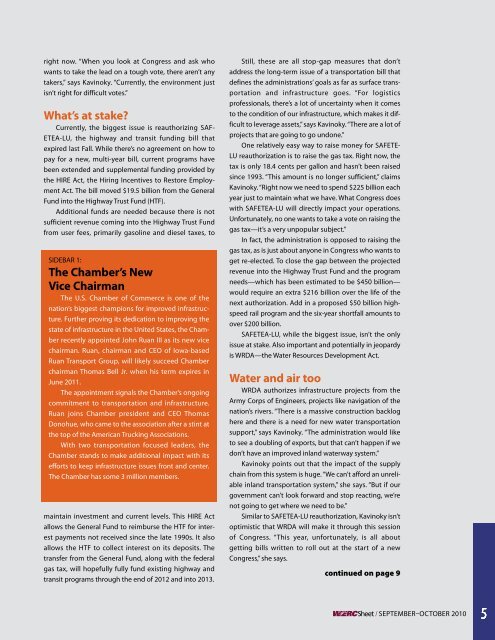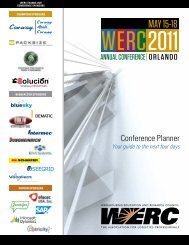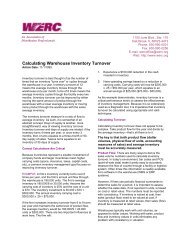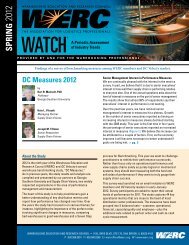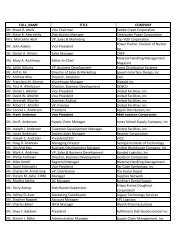Optimizing Inventory Management - WERC
Optimizing Inventory Management - WERC
Optimizing Inventory Management - WERC
You also want an ePaper? Increase the reach of your titles
YUMPU automatically turns print PDFs into web optimized ePapers that Google loves.
ight now. “When you look at Congress and ask who<br />
wants to take the lead on a tough vote, there aren’t any<br />
takers,” says Kavinoky. “Currently, the environment just<br />
isn’t right for difficult votes.”<br />
What’s at stake?<br />
Currently, the biggest issue is reauthorizing SAF-<br />
ETEA-LU, the highway and transit funding bill that<br />
expired last Fall. While there’s no agreement on how to<br />
pay for a new, multi-year bill, current programs have<br />
been extended and supplemental funding provided by<br />
the HIRE Act, the Hiring Incentives to Restore Employment<br />
Act. The bill moved $19.5 billion from the General<br />
Fund into the Highway Trust Fund (HTF).<br />
Additional funds are needed because there is not<br />
sufficient revenue coming into the Highway Trust Fund<br />
from user fees, primarily gasoline and diesel taxes, to<br />
SIDEBAR 1:<br />
The Chamber’s New<br />
Vice Chairman<br />
The U.S. Chamber of Commerce is one of the<br />
nation’s biggest champions for improved infrastructure.<br />
Further proving its dedication to improving the<br />
state of infrastructure in the United States, the Chamber<br />
recently appointed John Ruan III as its new vice<br />
chairman. Ruan, chairman and CEO of Iowa-based<br />
Ruan Transport Group, will likely succeed Chamber<br />
chairman Thomas Bell Jr. when his term expires in<br />
June 2011.<br />
The appointment signals the Chamber’s ongoing<br />
commitment to transportation and infrastructure.<br />
Ruan joins Chamber president and CEO Thomas<br />
Donohue, who came to the association after a stint at<br />
the top of the American Trucking Associations.<br />
With two transportation focused leaders, the<br />
Chamber stands to make additional impact with its<br />
efforts to keep infrastructure issues front and center.<br />
The Chamber has some 3 million members.<br />
maintain investment and current levels. This HIRE Act<br />
allows the General Fund to reimburse the HTF for interest<br />
payments not received since the late 1990s. It also<br />
allows the HTF to collect interest on its deposits. The<br />
transfer from the General Fund, along with the federal<br />
gas tax, will hopefully fully fund existing highway and<br />
transit programs through the end of 2012 and into 2013.<br />
Still, these are all stop-gap measures that don’t<br />
address the long-term issue of a transportation bill that<br />
defines the administrations’ goals as far as surface transportation<br />
and infrastructure goes. “For logistics<br />
professionals, there’s a lot of uncertainty when it comes<br />
to the condition of our infrastructure, which makes it difficult<br />
to leverage assets,” says Kavinoky. “There are a lot of<br />
projects that are going to go undone.”<br />
One relatively easy way to raise money for SAFETE-<br />
LU reauthorization is to raise the gas tax. Right now, the<br />
tax is only 18.4 cents per gallon and hasn’t been raised<br />
since 1993. “This amount is no longer sufficient,” claims<br />
Kavinoky. “Right now we need to spend $225 billion each<br />
year just to maintain what we have. What Congress does<br />
with SAFETEA-LU will directly impact your operations.<br />
Unfortunately, no one wants to take a vote on raising the<br />
gas tax—it’s a very unpopular subject.”<br />
In fact, the administration is opposed to raising the<br />
gas tax, as is just about anyone in Congress who wants to<br />
get re-elected. To close the gap between the projected<br />
revenue into the Highway Trust Fund and the program<br />
needs—which has been estimated to be $450 billion—<br />
would require an extra $216 billion over the life of the<br />
next authorization. Add in a proposed $50 billion highspeed<br />
rail program and the six-year shortfall amounts to<br />
over $200 billion.<br />
SAFETEA-LU, while the biggest issue, isn’t the only<br />
issue at stake. Also important and potentially in jeopardy<br />
is WRDA—the Water Resources Development Act.<br />
Water and air too<br />
WRDA authorizes infrastructure projects from the<br />
Army Corps of Engineers, projects like navigation of the<br />
nation’s rivers. “There is a massive construction backlog<br />
here and there is a need for new water transportation<br />
support,” says Kavinoky. “The administration would like<br />
to see a doubling of exports, but that can’t happen if we<br />
don’t have an improved inland waterway system.”<br />
Kavinoky points out that the impact of the supply<br />
chain from this system is huge. “We can’t afford an unreliable<br />
inland transportation system,” she says. “But if our<br />
government can’t look forward and stop reacting, we’re<br />
not going to get where we need to be.”<br />
Similar to SAFETEA-LU reauthorization, Kavinoky isn’t<br />
optimistic that WRDA will make it through this session<br />
of Congress. “This year, unfortunately, is all about<br />
getting bills written to roll out at the start of a new<br />
Congress,” she says.<br />
continued on page 9<br />
/ September–October 2010 5


